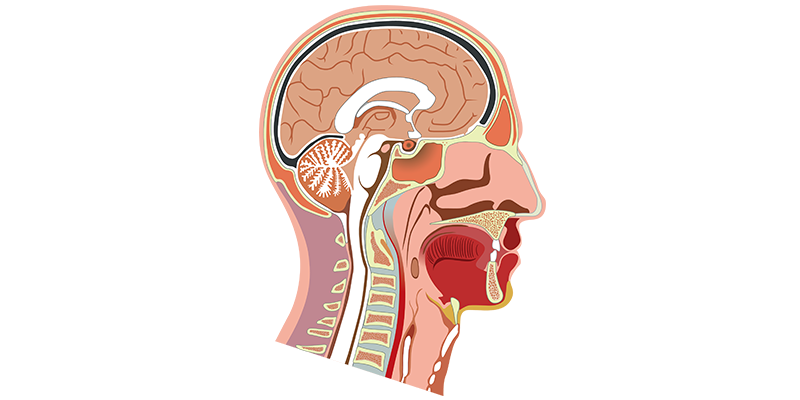
About Head and Neck Cancers
The cancers that are grouped under the name head and neck cancers usually begin in the cells that line the moist surfaces inside the mouth, nose, and throat. These are known as squamous cells. Squamous cell cancers are often referred to as squamous cell carcinomas of the head and neck.
As we treat these cancers, you’ll be part of our collaborative, personalized team approach. We stay flexible and nimble on your treatment journey so we can continue to offer different options as they arise or set new goals as needed. You’ll have a responsive, caring team of oncology specialists and nurses by your side all through your treatment.
Types of Head and Neck Cancers
- Hypopharyngeal cancer. The hypopharynx is the bottom part of one of the three sections of the pharynx (throat). This cancer develops when cancer cells form in the tissues of the hypopharynx.
- Laryngeal cancer. The larynx is a part of the throat and contains the vocal cords. Cancer cells form in the tissues of the larynx.
- Lip and oral cavity cancer. Parts of the oral cavity include the tongue, gums, and roof of the mouth. This type of cancer develops when cells form in the lips or mouth.
- Metastatic neck cancer with unknown primary. This is a cancer that has spread from another location in your body to your neck. An unknown primary means the original location of cancer has not been identified.
- Nasopharyngeal cancer. The nasopharynx is the upper part of the throat behind the nose, where it connects with the nasal cavity above the soft palate. This cancer forms in the tissues of the nasopharynx.
- Oropharyngeal cancer. The oropharynx is located at the back of the mouth, between the soft palate and the neck bone that supports the tongue. Cancer cells form in the tissues of the oropharynx.
- Paranasal sinus and nasal cavity cancer. The disease develops in the tissues of the nose and the four air-filled cavities, called the sinuses, around it.
- Salivary gland cancer. The salivary glands make saliva and release it into the mouth. There are three pairs of major salivary glands. This rare disease develops when cancer cells form in the tissues of the salivary glands.

“Dear Cancer: You’ve Got a Fight on Your Hands.”
With a PhD in computational chemistry and a deeply personal motivation rooted in the loss of his father to cancer, Dr. Adam Smith brings both scientific precision and heartfelt compassion to every patient he treats.

“Dear Cancer: You Can Never Weaken the Human Spirit.”
Infusion nurse Irene Paige brings strength, comfort, and expert care to patients receiving chemotherapy and immunotherapy at McGlinn Cancer Institute.
Diagnosing Head and Neck Cancers
We use advanced tools and methods to diagnose head and neck cancers.
- Barium swallow. A barium swallow can help identify abnormalities along the swallowing passage. You will swallow a liquid that contains barium and coats the lining of the esophagus, stomach, and intestines. This makes tumors or other abnormalities easier to see on an X-ray.
- Biopsy. A test that removes a small amount of tissue to be examined under a microscope. A fine needle aspiration is a common type of biopsy that detects head and neck cancers.
- Endoscopic procedures. These tests use a flexible lighted tube (endoscope) that has a video camera on the end that’s inserted through your nose into your throat and down the esophagus while you’re sedated. It allows the care team to examine areas inside your head and neck.
- Imaging tests. Pictures are taken of the inside of your body to look for cancer, learn how far it has spread, and help see if treatment is working. Types of imagine tests include computed tomography (CT) scans, nuclear medicine scans (such as bone scans and thyroid scans), magnetic resonance image (MRI) scans, and positron emission tomography (PET).
- Laboratory testing. These tests examine blood samples and include a blood chemistry study, Complete Blood Count (CBC), Epstein-Barr virus (EBV) test.
- Tumor marker test. A sample of blood, urine or tissue is checked to measure the amounts of certain substances made by organs, tissues or tumor cells in the body.

Treating Head and Neck Cancers
At McGlinn Cancer Institute, we have one goal: to find the best ways to treat your cancer so you can return to better health and enjoying your life. Our medical oncologists and hematologists work together with an entire team of highly skilled surgeons, nurses, and other specialists to create a treatment plan that focuses on therapies that target and destroy cancer cells.
- Chemotherapy (chemo). This treatment uses a drug that stops or slows the growth of cancer cells. Not only is chemo used to treat cancer, but it can also help ease symptoms since it shrinks painful tumors.
- Immunotherapy. Your immune system protects your body from illness and harmful foreign substances. Immunotherapy is just one form of precision medicine we offer that boosts your body's immune system - helping it recognize and attack cancer cells.
- Radiation therapy. This approach uses high-energy X-rays or other particles to destroy cancer cells. It may be the main treatment we use for head and neck cancer. It may also be used to destroy small areas of cancer that could not be removed with surgery. Two main types of radiation therapy include:
- External beam radiation. This is the most common form and is given from a machine outside the body. Intensity-modulated radiation therapy (IMRT) uses advanced technology to precisely direct beams of radiation at the tumor. This helps reduce damage to nearby healthy cells.
- Internal radiation therapy. Also called brachytherapy, this procedure places a tiny seed inside the body near the tumor site.
- Reconstructive surgery. Sometimes cancer surgery requires major tissue to be removed. This may include removing skin, the jaw, throat, or tongue. Reconstructive surgery may be done to replace the missing tissue. This surgery can help restore your appearance and improve how the affected area functions.
- Surgery. It is the most common treatment for head and neck cancers. Surgical techniques may include removing all or part of the voice box, throat, lymph nodes, the vocal cords, and other cancerous tissue.
- Surgical dissection. This is the standard treatment for metastatic neck cancer with unknown primary. Our skilled surgeons may perform radical neck dissection, modified radical neck dissection, or partial neck dissection.


